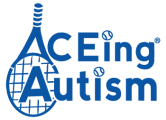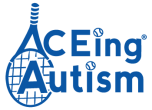Impact
What We Hear From Parents
Would recommend ACEing Autism
Are extremely satisfied with the
ACEing Autism program
Feel they found a meaningful activity for their child in ACEing Autism
How Do Children Benefit From ACEing Autism?
What We Hear From Program Directors
saw improvement in hand-eye coordination
saw improvement in the participants’ social and communication skills with volunteers and directors
saw improvement in eye tracking
saw improvement in the participants’ social and communication skills with other participants
Our survey results show that ACEing Autism’s program is a great vehicle to help connect kids through tennis with adaptive warm-ups and racquet skills, hand-eye coordination drills and games. Our program helps build a foundation for children to continue to engage in physical activity and provides broad areas of improvement in both motor and non-motor areas after participation.
Tennis skills, motor skills, and social skills showed the greatest area of improvement, suggesting that ACEing Autism is particularly well-adapted to engage children in group-based tennis and motor-skill activities that are also socially engaging with other participants and volunteers. ACEing Autism assesses participants’ improvement annually.
Additional Reading
You can find more information on the benefits of tennis and sports on children with autism through these studies.

